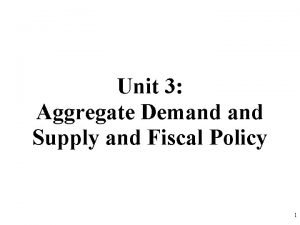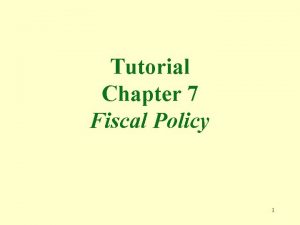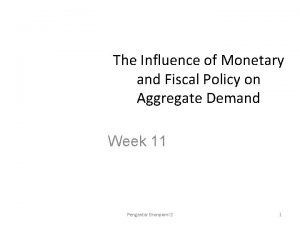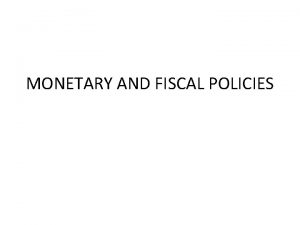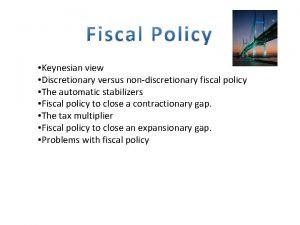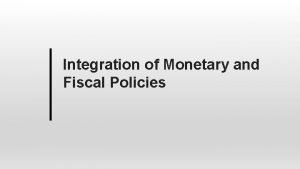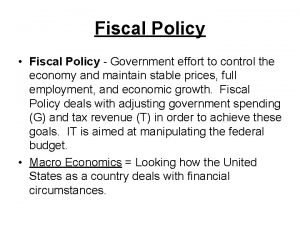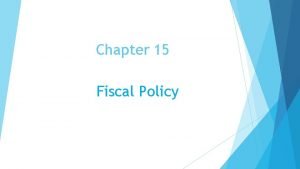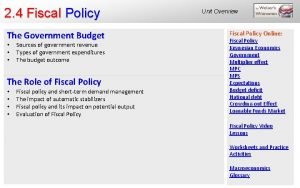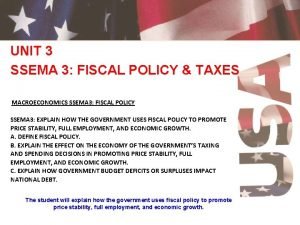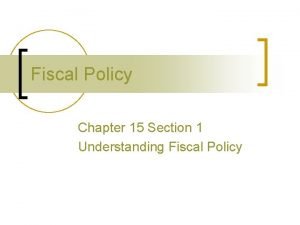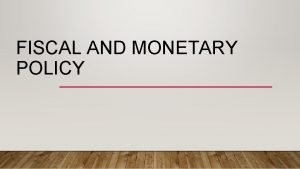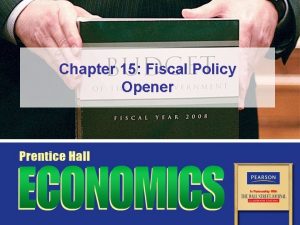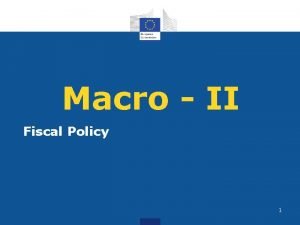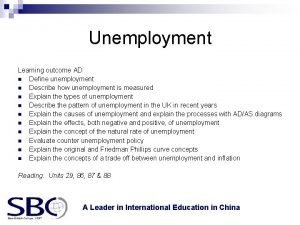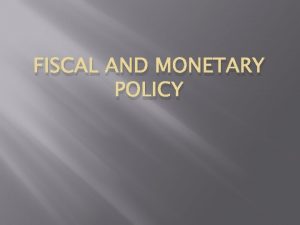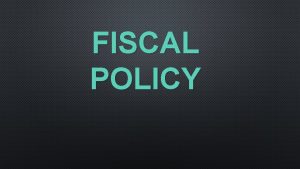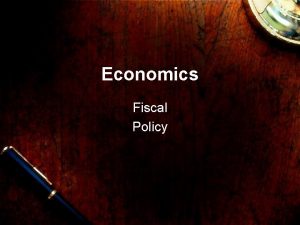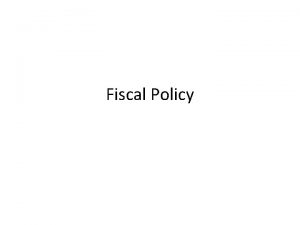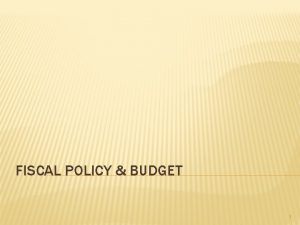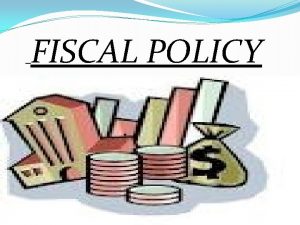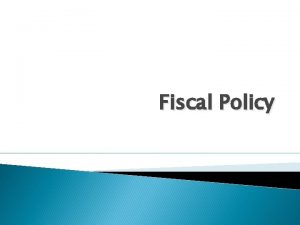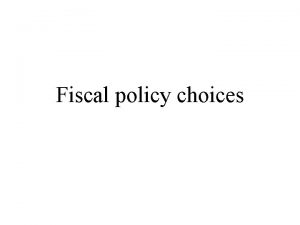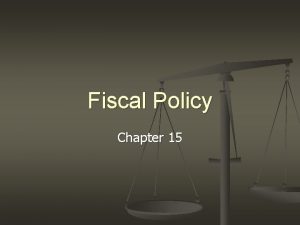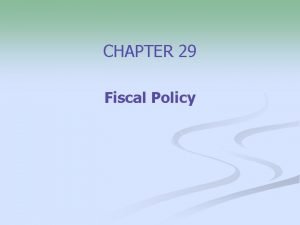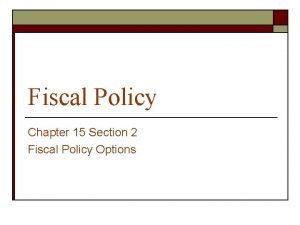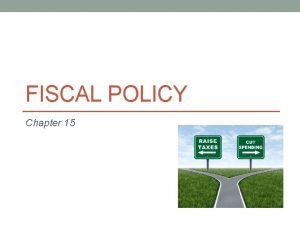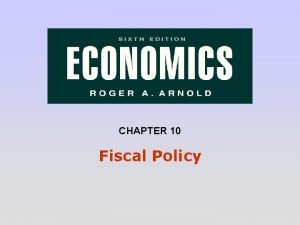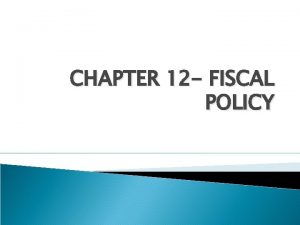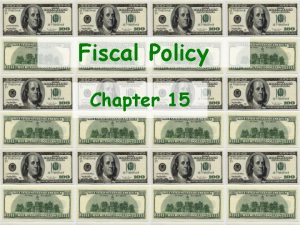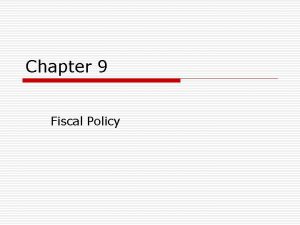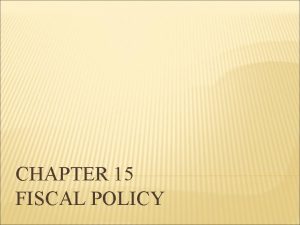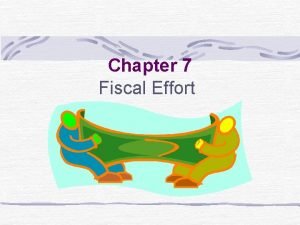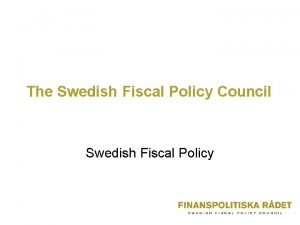Fiscal Policy Chapter 15 What is Fiscal Policy




























- Slides: 28

“Fiscal Policy” Chapter 15

What is Fiscal Policy? n The tremendous flow of cash into and out of the economy due to government spending and taxing has a large impact on the economy n Fiscal policy decisions, such as how much to spend and how much to tax, are among the most important decisions the federal government makes n Fiscal policy is the federal government’s use of taxing and spending to keep the economy

Federal Budget n The federal budget is a written document indicating the amount of money the government expects to receive for a certain year and authorizing the amount the government can spend that year… n The White House and Congress work together to develop a federal budget n Obviously varies from year-to-year but has been running about $3. 8 – $4. 094 (FY 18) trillion over last few years…



“G” and Fiscal Policy n Remember GDP = C + I + G + (X – M)? n The total level of government spending can be changed to help increase or decrease the output of the economy

Expand Contract n Fiscal policies that try to increase output are known as expansionary policies. Increase government spending n Decrease taxes n n Fiscal policies intended to decrease output are called contractionary policies. Decrease government spending n Increase taxes n

Expansionary Graph Effects of Expansionary Fiscal Policy High prices Aggregate supply Price level Higher output, higher prices Aggregate demand with higher government spending Lower output, lower prices Original aggregate demand Low prices Low output High output Total output in the economy

Contractionary Graph Effects of Contractionary Fiscal Policy High prices Aggregate supply Price level Higher output, higher prices Lower output, lower prices Original aggregate demand Aggregate demand with lower government spending Low output High output Total output in the economy

Why it doesn’t always work n Difficulty of Changing Spending Levels n n Predicting the Future n n Understanding the current state of the economy and predicting future economic performance is very difficult, and economists often disagree. This lack of agreement makes it difficult for lawmakers to know when or if to enact changes in fiscal policy. Delayed Results n n In general, significant changes in federal spending must come from the small part of the federal budget that includes discretionary spending. Even when fiscal policy changes are enacted, it takes time for the changes to take effect. Political Pressures n Pressures from the voters can hinder fiscal policy decisions, such as decisions to cut spending or raising taxes.

Coordination n For fiscal policies to be effective, various branches and levels of government must plan and work together, which is sometimes difficult n Federal policies need to take into account regional and state economic differences n Federal fiscal policy also needs to be coordinated with the monetary policies of the Federal Reserve (we’ll cover that

Quick Review 1. Fiscal policy is (a) the federal government’s use of taxing and spending to keep the economy stable. (b) the federal government’s use of taxing and spending to make the economy unstable. (c) a plan by the government to spend its revenues. (d) a check by Congress over the President. 2. Two types of expansionary policies are (a) raising taxes and increasing government spending. (b) raising taxes and decreasing government spending. (c) cutting taxes and decreasing government spending. (d) cutting taxes and increasing government spending.

Economic Schools of Thought n Classical Economics n Keynesian (a. k. a Demand Side Economics) n Supply Side Economics

Classical n Classical economics n The idea that markets regulate themselves n Adam Smith, David Ricardo, and Thomas Malthus are all considered classical economists. n The Great Depression that began in 1929 challenged the ideas of classical economics.

Papa Keynes n n n Keynesian economics is the idea that the economy is composed of three sectors — individuals, businesses, and government — and that government actions can make up for changes in the other two Keynesian economists argue that fiscal policy can be used to fight both recession or depression and inflation Keynes believed that the government could increase spending during a recession to counteract the decrease in consumer spending n Among the most influential economists th

Multiplier Effect of Government Spending n The multiplier effect in fiscal policy is the idea that every dollar change in fiscal policy creates a greater than one dollar change in economic activity. n n For example, if the federal government increases spending by $10 billion, there will be an initial increase in GDP of $10 billion. The businesses that sold the $10 billion in goods and services to the government will spend part of their earnings, and so on. When all of the rounds of spending are added up, the government spending leads to an increase of $50 billion in GDP…

Stabilizers n A stable economy is one in which there are no rapid changes in economic factors. Certain fiscal policy tools can be used to help ensure a stable economy. n An automatic stabilizer is a government tax or spending category that changes automatically in response to changes in GDP or income.

Fiscal Policy Grid

Supply-Side Economics n Supply-side economics stresses the influence of taxation on the economy. “Supply-siders” believe that taxes have a strong, negative influence on output… n The Laffer curve shows how both high and low tax revenues can produce the same tax revenues

Economic History n n The Great Depression n Franklin D. Roosevelt increased government spending on a number of programs with the goal of ending the Depression. World War II n Government spending increased dramatically as the country geared up for war. This spending helped lift the country out of the Depression. The 1960 s n John F. Kennedy’s administration proposed cuts to the personal and business income taxes in an effort to stimulate demand bring the economy closer to full productive capacity. Government spending also increased because of the Vietnam war. Supply-Side Policies in the 1980 s n In 1981, Ronald Reagan’s administration helped pass a bill to reduce taxes by 25 percent over three

Quick Review 1. What are the two main economic problems that Keynesian economics seeks to address? (a) business and personal taxes (b) military and other defense spending (c) periods of recession or depression and inflation (d) foreign aid and domestic spending 2. Government taxes or spending categories that change in response to changes in GDP or income are called (a) fiscal policy. (b) automatic stabilizers. (c) income equalizers. (d) expansionary aids.

Budgets n A budget surplus occurs when revenues exceed expenditures n A budget deficit occurs when expenditures exceed revenue n A balanced budget is a budget in which revenues are equal to spending

If there is a deficit… n Creating Money n n The government can pay for budget deficits by creating money. Creating money, however, increases demand for goods and services and can lead to inflation. (more next chapter) Borrowing Money n n The government can also pay for budget deficits by borrowing money. The government borrows money by selling bonds, such as United States Savings Bonds, Treasury bills, or Treasury notes. The government then pays the bondholders back at a later date.

n Types of Government Borrowing Treasury Bills – a. k. a “T-Bills” n n n Treasury notes n n 2 -10 years Treasury Bonds n n Repaid within a year or less 13, 26, 39, 52 week coupon books Up to 30 years Very small (think holiday gifts) Very large (other countries buy them) Generally, longer time higher interest to account for risk and opportunity costs n n n Government will raise the rate it pays to attract more people Right now rates are low because loaning money to the government is seen as safer than other markets Overall, the government borrowing is a complicated financial interaction – if interested, take a finance course in college

n The Difference Between Deficit and Debt n n Measuring the National Debt n n n The deficit is amount the government owes for one fiscal year. The national debt is the total amount that the government owes. In dollar terms, the debt is extremely large: ~$20 trillion Economists often measure the debt as a percent of GDP. The national debt is the total amount of money the federal government owes. The national debt is owed to anyone who holds U. S. Savings Bonds or Treasury bills, bonds, or notes.


Debt n Problems of a National Debt n n n To cover deficit spending the government sells bonds. Every dollar spent on a government bond is one fewer dollar that is available for businesses to borrow and invest. This encroachment on investment in the private sector is known as the crowding-out effect. The larger the national debt, the more interest the government owes to bondholders. Dollars spent paying interest on the debt cannot be spent on anything else, such as defense, education, or health care. Other Views of a National Debt n Keynesian economists argue that if government borrowing and spending help the economy achieve its

Quick Review 1. A balanced budget is (a) a budget in which expenditures equal revenues. (b) a budget in which expenditures do not equal revenues. (c) a budget in which the government spends money. (d) a budget in which revenues equal taxes. 2. Which of the following are problems associated with a national debt? (a) increased spending on defense and education (b) the crowding-out effect and interest payments on the debt (c) interest payments on the debt and too much individual investment (d) increased individual investment and decreased
 Conclusion of monetary policy
Conclusion of monetary policy Example fiscal policy
Example fiscal policy Fiscal policy practice
Fiscal policy practice Components of fiscal policy
Components of fiscal policy Crowding out effect of fiscal policy
Crowding out effect of fiscal policy Expansionary monetary policy effects
Expansionary monetary policy effects Instruments of fiscal policy
Instruments of fiscal policy Expansionary gap
Expansionary gap Fiscal policy
Fiscal policy Ib economics fiscal policy
Ib economics fiscal policy Fiscal demand side policy
Fiscal demand side policy Fiscal policy to control inflation
Fiscal policy to control inflation Contractionary fiscal policy
Contractionary fiscal policy Instruments of fiscal policy
Instruments of fiscal policy Crowding out
Crowding out Demand side fiscal policy definition
Demand side fiscal policy definition Short run effects of expansionary monetary policy
Short run effects of expansionary monetary policy Crowding out effect of fiscal policy
Crowding out effect of fiscal policy Example of expansionary fiscal policy
Example of expansionary fiscal policy How much does wanda earn per hour
How much does wanda earn per hour Goals of fiscal policy
Goals of fiscal policy Fiscal vs monetary policy
Fiscal vs monetary policy Goals of fiscal policy
Goals of fiscal policy Fiscal policy
Fiscal policy Unit 3 aggregate demand and aggregate supply
Unit 3 aggregate demand and aggregate supply Unit 3 aggregate demand aggregate supply and fiscal policy
Unit 3 aggregate demand aggregate supply and fiscal policy Fiscal policy diagram with explanation
Fiscal policy diagram with explanation Fiscal reform meaning
Fiscal reform meaning Features of fiscal policy ppt
Features of fiscal policy ppt

